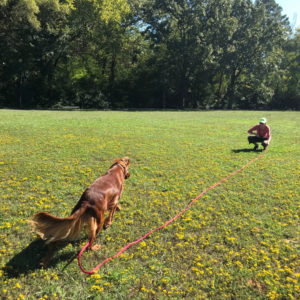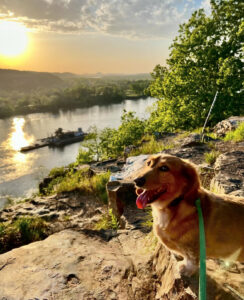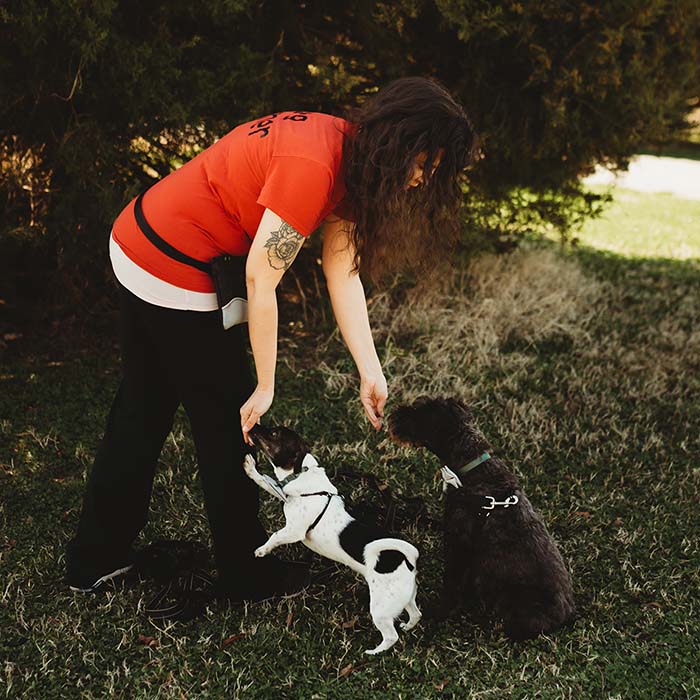“Hugely Rewarding and Just a Lot of Fun”: Training Your Own Assistance Dog with Hallie Wells
Podcast Transcript
[Intro]
At the end of the day, the dog has to be happy working and the dog has to be comfortable. And my clients are above and beyond aware of their dog’s happiness, and they put a lot of time and thought and energy into making sure their dog is happy, so if they aren’t, they let me know.
[Music]
Elizabeth Silverstein: Hi, welcome back to Telltail Dog the Podcast. I’m your host, certified dog trainer Elizabeth Silverstein, and I have with me again for part two, Hallie Wells, who is a certified dog trainer and owner and head trainer with Lumos Dog Training and Behavior Services. Thanks for coming back for part two, Hallie. How are you doing?
Hallie Wells: I’m good. How are you?
Elizabeth: Doing alright. So last time we discussed your training journey, how you got into working with dogs, your experience with guide dogs, how you started Lumos. For this one, I’d love to talk to you more about service dogs in general, guide dogs in general. So you’ve kind of got the training bug from working with guide dogs. What draws you to working with people? Especially with training their own guide dogs?
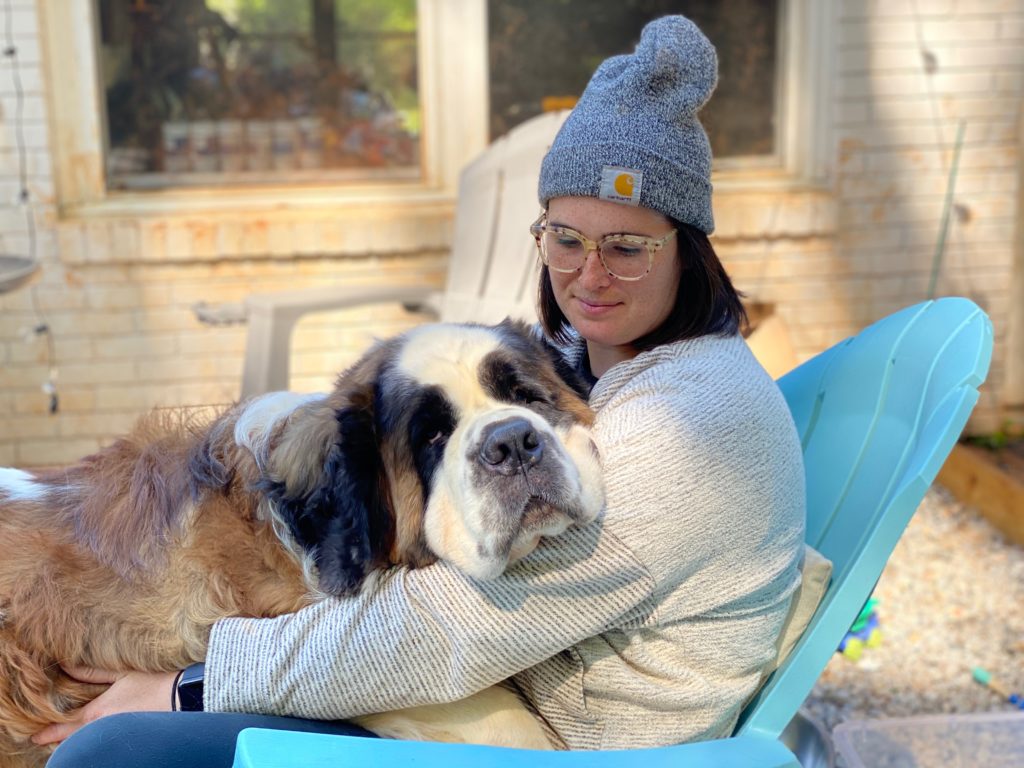
Hallie: I think what’s important for me with assistance dogs–so that covers the realm of service dogs and guide dogs–is that there are so many different aspects of it, and it’s not just cookie cutter training. Not that training ever is, but there might be someone that needs autism support, but they also might need light guiding tasks, or there might be someone who has a psychiatric service dog, but they also need some counterbalance support. So, I really love that you can really customize the dog training and the service dog training to suit their partner’s needs and accommodate what they’re looking for to gain that independence and have that partnership with their service dog.
Elizabeth: Okay. And I love that breakdown, too. So, there’s a lot that’s going on. So there can be more mental assistance, right, or the physical assistance or a mixture of both. And I’ve often had conversations with people of service dog or assistant dog, and then there’s emotional support, and then there’s therapy dogs, and those are kind of all very distinct, different things. What are some of the differences? Do you have some thoughts on those differences?
Hallie: Yeah! I think there’s a lot of stuff out on internet and out in publications that provide either misinformation or people are choosing to only listen to what they want. So, clarify: assistance dogs cover guide dogs for the visually impaired and service dogs for physical or psychiatric support. These are seen as tools, just like someone would need a wheelchair or a cane or a walker. These people are utilizing their service dog partner as that tool. An emotional support animal can be really any animal. Like your pet that you have at home is an emotional support animal, basically. Unfortunately, there is very vague phrasing and laws regarding emotional support animals, and people have kind of abused that phrase in the sense of, they say they need an emotional support animal to get easier access to housing or their pet fees waived or think that they can bring their dog anywhere with them. But emotional support animals do not have public access where pet dogs are not allowed. And assistance dogs–guide dogs, and service dogs–are allowed to go anywhere in the public space that people are allowed. And then, therapy dogs are dogs that are given access with permission to places that pet dogs might not be allowed, like hospitals or nursing homes or schools, and they have gone through a certification program. They’re extremely well behaved. They’re there to offer assistance or emotional support to different people. So, people maybe that are living in nursing homes and don’t have the ability to have their pet dog with them or have a pet dog, the therapy dogs can come and hang out with them. They visit people in in hospitals and stuff like that. But again, they don’t have public access where pet dogs aren’t allowed. So, the only dogs you should see working in public are assistance dogs: guide dogs and service dogs.
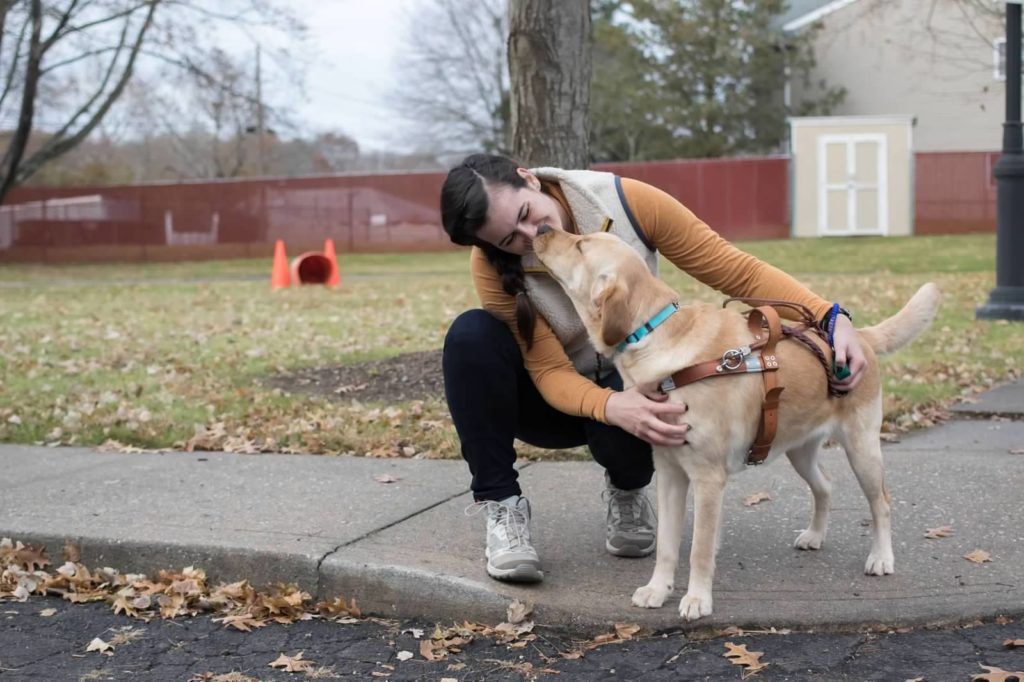
Elizabeth: The dogs I’ve seen, or the stories I’ve heard–when I was in California for a few months way back in 2015, way before I became a dog trainer, and this woman had a big old dog, a big old pitty. Cute dog. Huge. And she was telling this story that she thought was super funny about how she got a service dog designation for this dog, and he took a dump in the middle of the airport and then she just walked away from it. And that was a really horrifying story for me to hear. And it’s not the only story out there and I–definitely last time I flew, I saw a woman dragging around a terrified doodle with a service dog vest on, so we’ve all seen it. We’ve all seen those examples. And I know that that really takes away from the people who need these dogs to live basically. So, what makes a dog a service dog, assistance dog? A tool? How do they get that designation? Does that make sense? I’m like, I’m not quite sure of the question but–
Hallie: No, I totally understand. And that’s kind of, you know, people are like, ‘Well, I saw a service dog do this,’ and unfortunately, there is no regulation and there’s no certification in the United States. So, a service dog is deemed as a dog that is performing tasks for their partner in public. And you can just buy a service dog off Amazon or service dog vest off Amazon, and it oftentimes is the people that are faking their dog being a service dog, that are the most confrontational. And then business owners and the public don’t really know their rights as a person in public near a service dog, so service dogs are expected to be of the highest caliber of comfort in public. They cannot cause any damage, which means they cannot be urinating or defecating in public, in enclosed spaces or patios, stuff like that. They need to go to the bathroom and it needs to be in a space that humans are not going to be stepping in it and stuff like that. Obviously, accidents happen. I’ve had it happen with one of the dogs I was training myself, but I had the tools, because I was a responsible service dog trainer, to clean it up. And as service dog partners are working with their dog, they are aware of their dog’s body language and behavior and their comfort. They’re meeting their dogs’ needs, so the dog is comfortable in public and working with them, and their dog is not disruptive in any way, unless maybe they’re doing an alert for their partner having a seizure, and they’re responding to it. Stuff like that. There might be barking involved or jumping up involved, but they’re not going to be disrupting the public without cause. So they should be on a shorter leash. They should be attached to their partner or controlled by their partner in some way, with either a handheld leash, handle harness, something like that. Oftentimes, when you see a dog with a fake vest on, that’s just looking terrified out of their mind at the airport, and on a flexi lead, that is probably not a real service dog. But the rules and regulations are becoming more serious, so impersonating needing a service dog in many states is actually getting fined and there’s more regulation for flying with your service dog now. That emotional support animals are not allowed to be flown without being in the carrier and I think we’re recognizing that people are just taking advantage of the lack of regulation and it’s becoming dangerous to service dog users and partners and just the general public.
Elizabeth: It’s so serious, because people literally need their dogs to live their lives and so when other people just want their dog with them, it’s doing such a disservice to people that truly need it.
Hallie: Well, and also their dog hasn’t had the training and socialization service dog has been given. Service dogs usually start their job honestly from day one. And when they come home eight to twelve weeks old, they’re hitting the ground running with socialization. And they’re doing it with quality socialization. They’re not just dragging this puppy around everywhere they go and putting it into unsafe situations. The socialization should be very thoughtful and very predetermined and accessible to the dog in a way that feels safe to them. And it’s not fair to the dogs that are clearly stressed and having an accident in public and then their owner just leaving it. I don’t think that the people that impersonate needing a service dog, they don’t take it seriously because they don’t understand the work and time and effort that goes into making sure these dogs can work in public and feel comfortable doing it.
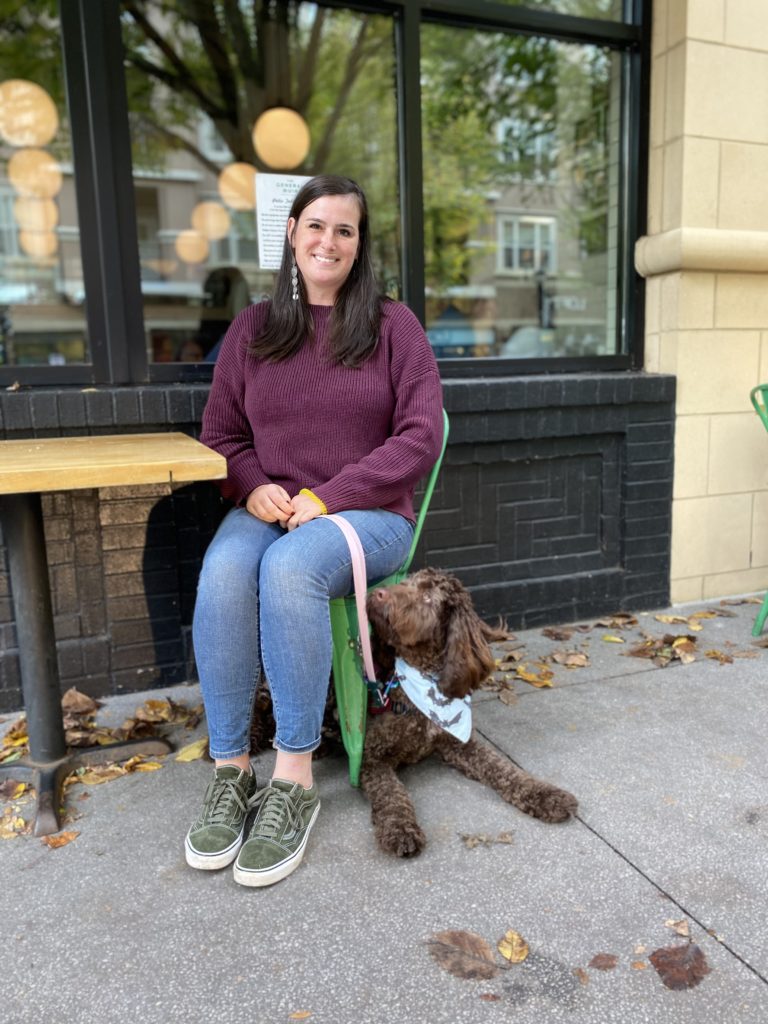
Elizabeth: That’s a very kind way of looking at it, because I think education is a huge aspect and I think sometimes–you mentioned the confrontation that people have, you know, with their untrained dogs of, just not feeling confident right in what you’re doing and if you’re not confident in what you’re doing, and someone’s calling you out for it then, yeah, that’s gonna be a little jarring, isn’t it? I haven’t done service dog training extensively. I know enough that the foundations are crucial, socialization is crucial, and I’ve had some people approach me for assistance with their service dog training. As I start to get into the details of what this dog needs, they often don’t continue with me, because I don’t think anyone is thinking how much actually goes into it. And I often compare it to working dogs. They’re working dogs, right? They’ve got a job.
Hallie: Yeah.
Elizabeth: It’s two years, right? It’s two extensive years from puppyhood to full adulthood for this dog to learn all these skills and get to where they need to be.
Hallie: Exactly. Yeah, I am working with several people that are finishing up with their training and I have one dog that is about 18 months, and she’s doing her final certification with our program at the end of the month, and her mom has probably dedicated at least an hour a day to training, outside of her socialization, outside of meeting her dog’s needs for energy and mental outlets. It’s a lot of work, and when you’re doing it yourself, it’s a huge investment. Of just like mental energy and physical energy and time. People are just like, ‘Oh, you just put a vest on and teach them to sit down when I stop walking, and then they’re trained, and they can go everywhere with me right?’ But it’s more than that.
Elizabeth: Often I think a big education component of all that is the whole, you know, distance, duration, distraction, difficulty. Your dog knowing a great sit-stay in the house does not mean that your dog’s gonna have a great sit-stay on a plane or in a restaurant and all that stuff. And that that takes time.
Hallie: Yeah. It does take a lot of time. And I tell people that, when I’m working with clients that have their eight-week-old puppy, and they’re so ready to get started and they’re so excited, and they can’t wait, and they’re like, ‘Well she doesn’t know this and this and this and this and this yet,’ and I’m like, ‘Okay that’s fine.’ We rarely even start with obedience. We start with socialization. We start teaching stimulus control from day one. We start teaching how dogs can disengage from distractions and it can be hugely reinforcing to them. We start with fun socialization. We get to obedience around like, I don’t know, we teach place first and touch and so we really don’t even get to sit and down and stay with an actual verbal cue until they’re probably like five or six months old because I can teach that in a few seconds to a dog and so can most my clients by the time they have been working with me for a while because their education is being invested into with their training of their service dog as well. So people don’t recognize what’s important with teaching a service dog how to learn and how to learn in public. And it’s so different than having your pet dog that sometimes goes on walks around the neighborhood and pops into a pet store with you.
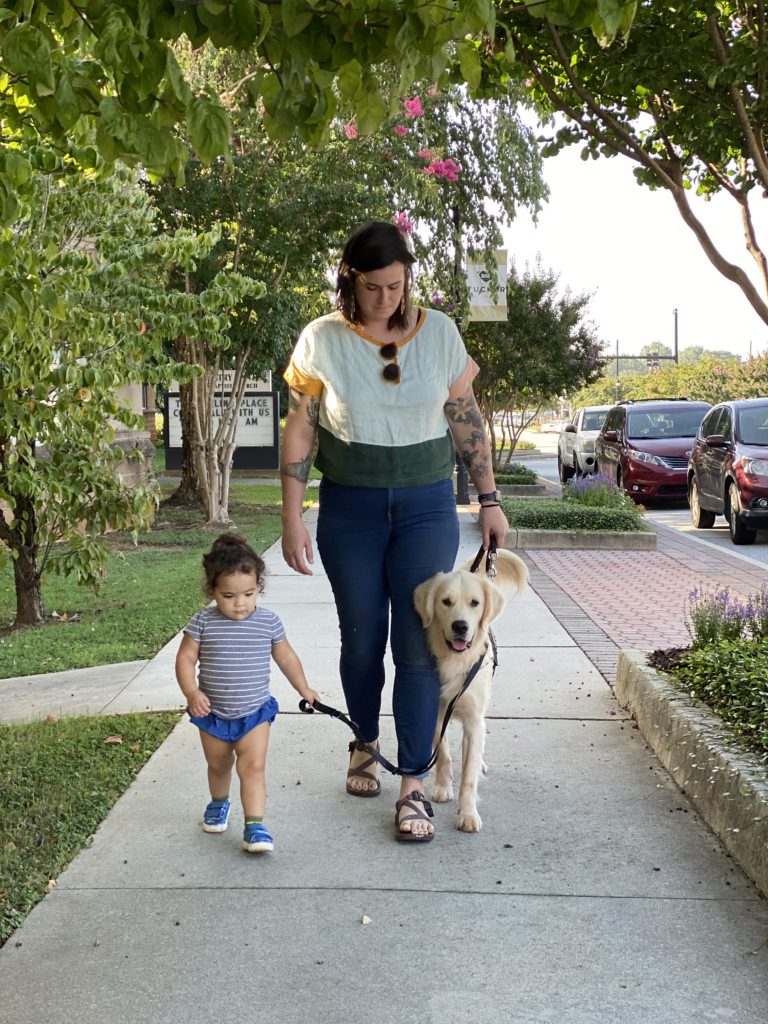
Elizabeth: I have a little nine-pound Toy Fox Terrier and she’s pretty good in public. And I tried flying with her, and I did very little acclimation to her carrier, and we had never even stepped into an airport. And she had a very hard time, very understandably, and that was on me. [Laughs]
Elizabeth: As soon as we were in the air, she’s fine, because she got lulled to sleep and she was fine. But yeah. And it can be embarrassing. And then as a trainer, I knew better, but I was in a time crunch. And so we often sometimes make choices that aren’t the best for getting them used to it.
Hallie: But it’s also sometimes if you don’t have the support of, here’s what goes into taking your dog to the airport. It’s getting them comfortable on public transportation, because most airports that are bigger have like air trains and buses and shuttles you have to take, and then, it’s the stop and go of waiting in lines and having other dogs around and the slippery floors and going through security and escalators and elevators. It is definitely the marathon of a public access training day for service dogs for sure.
Elizabeth: Mmhmm. And there’s also the element of, some dogs don’t want to be a service dog, right? Or they’re not a good fit for it, right? Does that come up with your service dog training?
Hallie: It does come up. I wish that every dog that started my program made it as a service dog, but thankfully, that is part of my client’s education, and a lot of times, they recognize it even before I notice it, because when I’m working with my clients, we’re doing training sessions through virtual training and so I’m seeing their dog loving the training session. Super engaged, because we’re training usually in their home. And then they’re sending me videos of the dog generalizing in public and sometimes those videos, because the dog is so engaged in the training, they’re on it. Their body language is engaged. They’re excited. But then their parent might say ‘Hey, they’re super sniffy when we’re just walking’, or ‘They are getting really scared by certain things that they weren’t scared of before.’ And a lot of that is because as the dog progresses in their training, we are supporting the dog less and less and the dog has to start supporting their partner and that pressure is really challenging for a lot of dogs to handle. But thankfully, I have a really amazing community of past clients and pet dog families and people that are interested in welcoming a dog into their home so we can usually find the right home for the dog if the service dog person cannot keep this dog. Because, I mean a lot of them, they need this dog as a tool and so they have to make these really heartbreaking decisions to either keep the dog as a pet or to find the best home for their dog, which is a really tough decision. But at the end of the day, the dog has to be happy working and the dog has to be comfortable and my clients are above and beyond aware of their dog’s happiness and they put a lot of time and thought and energy into making sure their dog is happy. So if they aren’t, they let me know.
Elizabeth: Wow. And that’s so special to look at it that way of, I need this dog to help me, but I also need the well-being of this dog to be good. I need this dog to be happy.
Hallie: Yeah, it’s a partnership. A lot of our language with service dogs is very much, ‘The dog is working for you.’ It’s a service dog user, and I’m trying to just shift my perspective of, it’s a service dog partner. Because the dog is supporting the person, but it’s also the person’s job to meet their service dog’s needs. And sometimes most of them are met through working for some dogs, because they’re with their person. They’re training. They’re being mentally stimulated. They’re getting exercise. But sometimes it’s beyond that. Sometimes their dog might have been working for ten days straight with very little break, and so they might give them a couple days off and give them extra sniff walks or give them extra time in the yard to just amble about and smell things and maybe some decompression time with food puzzles. Stuff like that. We definitely go over a lot of that. But it’s a partnership. It is a relationship. It’s not [that] we’re forcing this dog to be used by someone.
Elizabeth: And what do you–when someone comes to you and says, ‘I want to train my service dog’? Where do you start with them?
Hallie: I start with an initial email. I would say probably–I mean, I would have to look at my metrics–but probably 75% of people don’t go beyond the initial email, because 1) they don’t recognize the cost investment. Even though I keep my costs low, you still have to pay me to do this. There are plenty of non-profits that work with people that are unable to provide monetary investment or provide less than what I’m offering. And sadly, actually some of them require more of a donation than what I’m offering. But I send an initial email with my price range and what is included with the price range, and really what a service dog prospect needs to look like. What sort of socialization they need. What genetics, like genetically, what is this dog like? What is their personality like? What is their temperament like? And then I go over the time investment it takes for the human to train their dog and what tasks we can train realistically. What can this dog do? And so that is the start of the process. Some people already have their dog, and they’re just shopping around for a trainer. Some people don’t have a dog yet. My ideal client would not have their dog yet, and would be willing to let me find the prospect for them.
Elizabeth: And then you can do that–like you said, rescue or direct them to a breeder?
Hallie: Yes, I have a partnership with a lot of breeders, and I did a ton of study on highly heritable traits with dogs and different dog breeds, and that required me reviewing probably upwards of a thousand–probably thousands at this point–puppy tests that go through how the dog copes with added stress and stimulus to their environment. How they handle it. What they do. How they engage with the handler throughout the test. Stuff like that. So I have a pretty well-rounded understanding of, if we’re looking at an eight to ten week old puppy, this is what we are looking for.
Elizabeth: And with the breeders, do you have stringent requirements for that, too? Because I know a breeder can make or break how a dog turns out, too, in a lot of different ways.
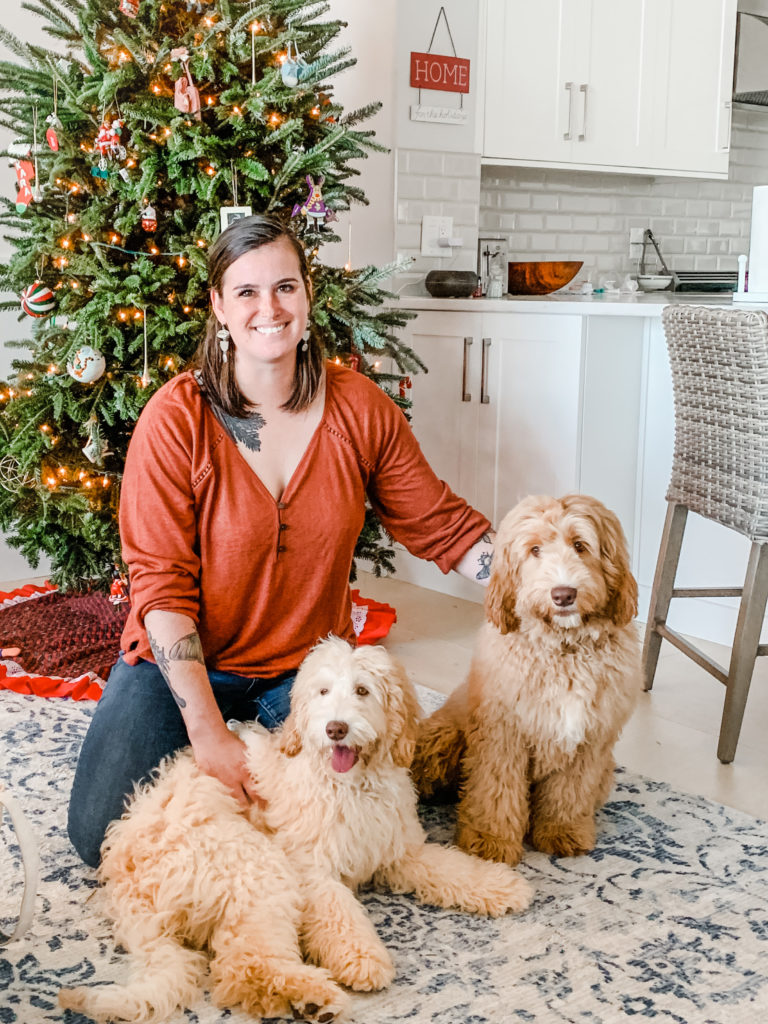
Hallie: Yes. They have to do early neurological stimulation. The parents need to be health tested and that means pen, hips, eyes, hip, and heart. I work with several breeders that also do the dog’s elbows, and they keep track of all of their offspring and any behavior or health problems they might have. Wnd we also focus on a breeder that understands the importance of early socialization beyond the ENS, early neurological stimulation. So what is the puppy experiencing before they go home and how are they experiencing it? That doesn’t mean throwing the puppy in with a bunch of kids or yeah, they met other adult dogs that weren’t their mom. It’s thoughtfully exposing them to different noises, textures, and problem solving, and generalizing different things. But it’s really important that the breeder understands the breeder’s job [is] to give the dog a head start, whether they’re going to a pet dog home or a service dog home.
Elizabeth: Yeah, I’ve seen a lot of puppies that can’t go outside on the grass, and I’m like, ‘Well, it kind of looks like your breeder didn’t let them experience grass.’
Hallie: Yep, and then the aspect with rescue is we don’t know if the parents had good nutrition when they were being bred, especially the mom while she was pregnant. We don’t know the stress levels of the parents, especially the mom while she was pregnant. We don’t know what sort of socialization they got. So, it can be done, but it is much harder to use a rescue dog, even if it’s a puppy. Even if the dog was, the puppy was born in a foster home that did everything right as far as socialization. There’s a lot of unknown factors that just winnow the chances of that dog feeling safe and wanting to do the job. That doesn’t mean it can’t be done, but it definitely makes it more challenging.
Elizabeth: Well, I think, Hallie, that was all the questions that I had. Was there anything else that you wanted to add?
Hallie: No, I think that’s it. Those were great questions.
Elizabeth: [Laughs] Thanks. I try to try to be thorough. And there’s a lot here. There’s a lot I wanted to touch on. But I’m excited to refer people to you the next time I get a request for service dog training because I think it’s fantastic that you have the message set up and the information already ready to go. I’m like, I can get you started. We can really get some good training in, but when it comes to specialized tasks, I could do some mobility but a lot I don’t even know, so I’m excited.
Hallie: Most good, ethical dog trainers can do it. It’s just understanding the stimulus control and generalization is just really advanced. The training is very simple. And it’s pretty easy once you know what you’re doing, but it is the generalization that is just so much work. But most trainers that I know and work with and admire, I’m like, ‘Yeah, you could do this. There’s no need to think this is cool. You teach amazing tricks where your dog does a handstand on the wall, and I’m teaching a dog to push a button.’ [Laughs]
Elizabeth: [Laughs] Yeah, that’s still pretty cool. And yeah. I think, too, that’s an interesting point. There’s so much cool things we could do with the dogs, and I just go back to that, your clients and you’re looking at it like honoring that relationship and honoring what they’re offering to us is such a beautiful thing.
Hallie: Yeah.
Elizabeth: Hallie, I’m going to go ahead and do the little sign off.
Elizabeth: This has been Telltail Dog the podcast, with your host, Elizabeth Silverstein, certified dog trainer in central Arkansas and my guest today, Hallie Wells. Music has been provided by Jim Ciago of Seven Second Chance. Find more of his work on iTunes and Spotify and stick around for after the music for some final advice from Hallie.
[Music]
Elizabeth: Hallie, before we sign off completely, if someone is thinking, ‘I need a service dog,’ where should they start?
Hallie: The first place that a prospective service dog partner can start is actually looking on the assistance dog international websites. And going there can help you find the nonprofits that are available and have resources to finding the right service dog. But if you would like to train the service dog yourself, which is hugely rewarding and just a lot of fun and enjoyable for a lot of people, and that’s why they make that choice, you can start by looking for service dog trainers in your area that use positive reinforcement and have the skillset to teach your dog and help you find the right prospects.

